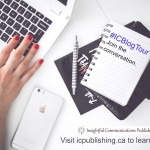In Part 1 of The New World of Publishing Series we discussed different ways you could publish your book, as well as the importance of your own goals in that process. For deeper learning and handy reference, we also included extra links to expand on the points outlined.
Here, we elaborate on some of the micro and multi-layered steps involved in publishing to help you understand further all the areas that require your attention, and/or your publisher’s focus and expertise. Since there’s a lot to cover, we’ve kept it point form; however, if there is something you’d like us to elaborate on, feel free to comment or contact us directly and we’ll do our best to assist you.
3. Main steps in the Publishing Process:
- Creative (writing/completing your book), Manuscript Evaluation
- Research (depending on genre), including obtaining permissions for quote use, etc.
- Goals, including timelines, marketing plan, platforms (especially social media)
- Sourcing support and services
- Budgeting time and costs
- Graphic design for cover
- Pre-Marketing
- Editing and Proofreading (numerous phases)
- Inside book design and typesetting
- E-Conversions
- Printing
- Ongoing Marketing (see our Author Checklist)
4. Key Components to Creating a High Quality Book for Today’s Marketplace
- Creative liberties aside, editing and proofing to industry standards is very important, especially as a new author wanting to make a great first impression (the style guide we use is well-known, and it is called, The Chicago Manual of Style).
- A unique, crisp, professionally created cover design is essential, to give a sense of what the book is about—and attract your target audience, especially if they don’t know you. Think of all the places your cover will be viewed, electronically and in print.
- High quality printing with printers that specialize in book printing. Your book is typeset using InDesign and Quark book design programs, which also produce proper specs for printing.
- E-Conversion formats include:
i. E-book (PDF)
ii. Mobi (Kindle e-reader)
iii. ePUB (for all other e-readers)
Electronic formats can be sold on independent sites just like print books, and are also uploaded to applicable e-stores, such Amazon.com, Sony, Barnes & Noble, Apple, etc. (we currently post to about 12 e-store sites).
Once you have found a publisher (partner or traditional), the production and publishing process takes four to six months on average, although it can be longer.
- Self-publishing will usually take longer, for obvious reasons—the author would be doing all the steps themselves and/or researching, sourcing, hiring for certain services.
- With respect to traditional publishing, the whole process can be significantly longer still, due to the time it usually takes to find one.
5. Promotion includes:
- Pre-marketing
- Book launches (Soft launches or pre-launches can be considered. A private pre-launch might suit when you wish to release your book to a certain audience first. A soft launch makes sense when you are releasing the e-versions first, with the print version shortly after.)
- Book signings at Chapters Indigo, and independent stores (depending on your genre, some fit the Chapters’ demographics better than others).
- Radio and TV interviews
- Virtual Book Tour (This is a series of guest blogging opportunities pitched and planned ahead on other blog sites with audiences similar to yours—content is always king, be sure to provide good value . . . radio and TV interviews can be included in the book tour as well.)
- Virtual Blog Tours with others (My blog administrator and I participated in “The Writing Process Blog Tour” earlier this year. And we launched the I C Publishing Summer Blog Tour in June on “Navigating the Writing Path: From Start to Finish”. It’s been highly interactive, exceptional talent and inspiration sharing, and it’s still going strong past many borders.)
- Talks with focused book signings (geared to your book’s audience).
- Ongoing marketing, including social media, and networking events.
- Marketing material, from press releases, media kits to book marks, etc.
- Authors’ blog and/or website—helps to build a following.
- Author’s full engagement in everything, based on their goals . . .
Yes, it sounds like a lot. In a way, it is. Yet, it’s also likely very similar to other learning you’ve experienced. Just take it one step at a time. Research, ask questions, consult with experts, digest what you can at a pace that works for you, and surround yourself with professionals that believe in your work as much as you do.
Then, be courageous and move forward. It’s so exciting when you start to see what you envision become a reality. Even better is the feeling when someone reads your book and you know that you’ve helped them in their personal or professional journey.
For more insights and encouragement, I invite you to follow my “From Business & Life Savvy to Book Author” Series on LinkedIn.
Here’s to your success,
Sheri and the I C Pub Team
Where applicable, every attempt has been made to cite, give proper acknowledgement, and/or access appropriate permissions for content used in our publications (books, blogs, and social media). For images, if not created in-house, we source via reputable image platforms. In the unlikely event something has been missed, please accept our apology and contact us immediately so we can investigate and/or delete accordingly.





Recent Comments